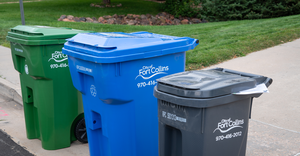Sendle Tackles Shipping Waste While Shooting for Net Zero

Sendle says its Australia’s first 100% carbon neutral delivery service—currently serving over a million users globally, helping them, too, reduce their carbon footprints. In this Q&A, Veena Harbaugh, director of Sustainability for Sendle, discusses the company’s carbon neutrality program and its latest more ambitious goal to get to net zero carbon by 2030. She touches on the shipping industry’s impact on the environment; how couriers can be more sustainable; and how to tell if those who claim to be serious about cutting their carbon footprint are walking the talk.
Waste360: How does Sendle reduce its environmental impact?
Harbaugh: Sendle is a Certified B Corporation, reducing the environmental impact of shipping by tapping into existing shipping providers and filling empty space in their vehicles to ensure every trip is maximized.
In addition to what we do within our own operations, we purchase carbon offsets to address the emissions from every parcel sent via the Sendle network. We calculate the highest amount of carbon that could be generated by any package sent, which produces a carbon yield number. Using that number as a guide, we use a portion of each package cost to fund sustainability projects. To date, Sendle has offset 18 billion miles of carbon.
Waste360: Tell us more about your carbon offsetting program to achieve carbon neutrality.
Harbaugh: As part of this program, we invest in global sustainability projects through our partnership with the South Pole (developers of emission reduction projects). This partnership enables us to support world-changing initiatives aimed at preserving and regenerating natural ecosystems, and we’re excited to be helping restore endangered rainforest habitats in the U.S., Canada, and Australia. By doing so, we ensure that all Sendle deliveries on land are 100% carbon neutral.
To also get our communities involved, we ask our small business customers and employees to select what carbon offset projects they want Sendle to invest in. For example, we’ve chosen four biodiversity and reforestation projects to support in 2022. They include:
Beidler Forest Conservation, South Carolina, United States
Darkwoods Forest Conservation, British Columbia, Canada
Tasmania Native Forest Protection, Tasmania, Australia
Mount Sandy Conservation, South Australia
Waste360: Why are you as a parcels shipper so focused on carbon neutrality?
Harbaugh: Shipping parcels creates pollution both in terms of carbon emissions and packaging waste. Knowing that delivery trucks are big contributors to climate change, our co-founders wanted to take full responsibility for Sendle’s carbon footprint by carbon offsetting the emissions generated by every parcel sent via the Sendle delivery platform.
It’s an industrywide problem. For example, the eCommerce boom is inadvertently contributing to the climate crisis and an environmental awakening couldn’t be more urgent across the shipping and logistics industry, which produces about 17 percent of global greenhouse gas emissions (GGE) from light and heavy trucks, aviation, rail, and sea. Meanwhile, the World Economic Forum estimates we’ll see 36 percent more delivery vehicles around our cities by 2030.
Waste360: I understand you are aiming to go beyond carbon neutrality and shoot for net zero by 2030. What’s your approach, and much impact do you think you can make?
Harbaugh: As part of our commitment to net zero by 2030, we will dramatically reduce the carbon footprint of our network through electric vehicles, network utilization, and engaging customers in more sustainable choices, such as grouping parcel pick-ups and selecting low-carbon delivery options.
Our goal of net zero by 2030 is a benchmark that puts the company 20 years ahead of the targets set in the Paris Agreement while further establishing Sendle as the go-to green shipping solution.
Sendle’s net zero commitment was established in 2019 with 500 other B Corps, and now over 1,000 B Corps have committed. This community of businesses that are legally accountable to all stakeholders, as well as the environment, shows a clear message that how we achieve net zero matters. These businesses are centering historically marginalized communities around the world — those who are currently and will be most affected by the devastating impacts of climate change in their paths to achieving net zero.
Waste360: How much have you invested to get to carbon neutrality and on exactly what?
Harbaugh: In our home country of Australia we launched Australia’s first solar-powered electric delivery vehicle fleet with one of our delivery partners. The solar panel array on top of the warehouse depot in Sydney produces over 600 kW of electricity per day. Seven times more power is generated by the solar panels than is consumed by the EVs. The excess power goes back to the grid and offsets the power consumption at other delivery depots. We’d like to launch a similar initiative with one of our delivery partners in the U.S. in the near future.
Waste360: What advice can you provide to stakeholders along the supply chain to be able to work more efficiently and more environmentally consciously?
Harbaugh: Everyone has a part to play in the ecosystem. Business owners who handle shipments can reduce packaging waste by switching to sustainable and compostable packaging materials.
Shipping companies can switch to electric vehicle fleets or convert to solar power whenever possible. It’s best to maximize their vehicle loads—try to fill vehicles to full capacity instead of driving from A to B with only a few packages. These are other actions companies can take:
Build warehousing that incorporates on-site renewable energy production.
Source local products or ones produced in regions where trucks are frequently “back-hauled” empty to distribution hubs.
Offset 100% of carbon emissions by investing in Earth-saving environmental projects.
Waste360: How can you tell which companies are seriously committed to net zero?
Harbaugh: In our industry, an easy way to tell which companies are serious about commitments to net zero is by looking at how they’re solving the supply chain disruption. If they’re committed to net zero by 2040 or 2050, but they're purchasing fleets of cargo airplanes, it’s clear they’re counting on another decade of heavy polluting before they start meaningfully reducing their greenhouse gas footprint. They're crossing their fingers that costs of carbon removal fall enough to make up for their lack of reduction and investment now.
But if they’re solving it with additional warehousing with on-site renewable energy, shifting demand to small businesses, or engaging their customers on climate-positive solutions— they’re pursuing a meaningful path to achieve their net zero commitment.
As EVs and other technologies hit their financial inflection point, inauthentically pursuing net zero is no longer just an immoral response to a market failure. It's another kind of business failing— a change management issue and inability to innovate. To truly address the climate crisis and commit, businesses and governments need to take responsibility and action today— not next week, next year, or in the next 10 years.
This article has been edited for length and flow.
About the Author
You May Also Like




